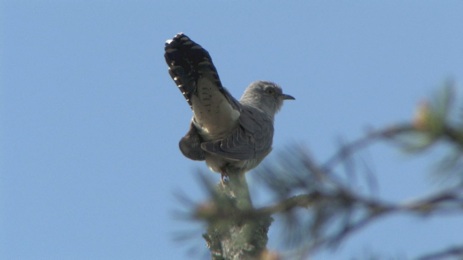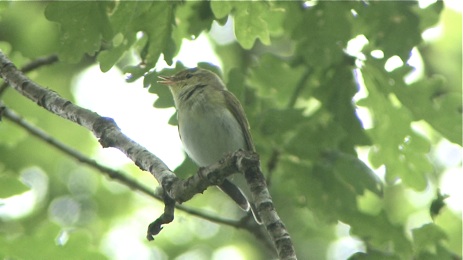Birds Near and Far
Home books dvds apps sites extra maps links contact us blog Buy
Birds Near and Far
Home books dvds apps sites extra maps links contact us blog Buy
A blog by Dave Gosney about some of the birds and places that feature in his books and DVDs but also about the state of birds in the Sheffield area

6th April 2014
Even scarcer than we thought
Evidence from the BTO’s Timed Tetrad Visits suggests species such as Cuckoos have declined significantly around Sheffield since a survey in 2003-08
I've really enjoyed studying the species maps in the new book Breeding Birds in the Sheffield Area. As I said in an earlier blog post, they paint a fascinating picture.
But after covering 50 tetrads for the BTO Bird Atlas in the years since the SBSG survey, my feeling was that some of our birds are even scarcer than they appear in these maps. So, when I was granted access to the BTO data for the Timed Tetrad Visits (TTVs) for the SBSG Area I was keen to test whether my observations in those 50 tetrads were borne out over the whole area (300 tetrads).
Here's a very simple analysis. It shows, for selected species, the total numbers counted in 813 hours during TTVs in the Sheffield area between 2008 and 2011. The figure in the final column shows how many tetrads that species was found in during 2003-08.
Number counted in Number of occupied
813 hours 2008-11 (BTO) tetrads 2003-08 (SBSG)
Corn Bunting 0 3
Dunlin 1 12
Hawfinch 1 0
Turtle Dove 1 8
Twite 1 2
Pochard 2 2
Red-breasted Merganser 2 19
Lesser Spotted Woodpecker 5 51
Ruddy Duck 5 13
Redshank 8 26
Marsh Tit 11 12
Tawny Owl 12 178
Pied Flycatcher 17 51
Teal 17 24
Yellow Wagtail 19 24
Wood Warbler 22 56
Little Grebe 28 60
Snipe 40 79
Spotted Flycatcher 45 120
Willow Tit 49 94
Lesser Redpoll 53 85
Whinchat 58 72
Cuckoo 60 119
Grey Partridge 63 107
Sparrowhawk 78 220
Buzzard 103 117
Tree Pipit 106 104
Redstart 112 120
So, in 813 hours of birding in the Sheffield Area, only 1 Dunlin, 1 Turtle Dove, 5 Ruddy Ducks and 11 Marsh Tits were counted. And no Corn Buntings. That doesn't mean there are no Corn Buntings left in the area but it gives a really clear picture of just how scarce they must be.
Of course, any 1-hour count is only going to pick up a proportion of the birds present. Some birds will always be missed, especially the more elusive species such as Lesser Spotted Woodpecker and nocturnal birds such as Tawny Owl. But, if you do 813 counts in 300 tetrads, that's almost 3 hours per tetrad. So, if Wood Warbler is present in 56 tetrads, that means about 150 hours were spent in those tetrads that should have Wood Warblers - yet only 22 Wood Warblers were counted. In fact they were found in only 11 different tetrads during those TTVs; in the other 45 tetrads, known to be occupied during 2003-08, no Wood Warblers were found despite, on average, almost 3 hours in each of those tetrads.
Wood Warblers were not found in 80% of the tetrads that had been occupied as recently as 2003-08
The figures for Cuckoo are even more alarming. About 300 hours were spent in areas which, according to the latest distribution maps, should still have Cuckoos yet only 60 Cuckoos were counted. Now that's not a bird that is easily missed, especially in 3 hours of visits. The one's that WERE counted were found in only 42 tetrads - there were 77 tetrads occupied as recently as 2003-08 where no Cuckoos were heard despite, on average, 3 hours being spent in each. They weren't found in almost two-thirds of the 'occupied' tetrads.
If, for each species, you multiply the number of occupied tetrads by 3 and 'round down' a little to get the number of hours spent, you get other startling outcomes like 45 Spotted Flycatchers and 63 Grey Partridge in 300 hours each, 28 Little Grebes in 200 hours, 49 Willow Tits and 53 Redpolls in about 250 hours each. And remember we're only including the time spent in places which, according to the most recent maps, SHOULD have those birds.
What I'm saying is that, although the maps paint a bleak picture for some species, in reality the picture is actually even worse. In some cases much worse. Why is that? It's partly because, as with most distribution surveys, tetrad atlasses put no limit on the time spent in any tetrad. A dot on the map means that species was found in that tetrad at some point during the survey. That might have been in one year only, or even one day only. And, crucially, it might have been at the beginning of the survey period. In this case, some of the dots on the maps may be telling us about birds that were found in 2003. Here is evidence that some birds have already gone from many of those tetrads since then. For some of these species, if things were bad during 2003-08, they are obviously much worse now. The rate of change is staggering.

